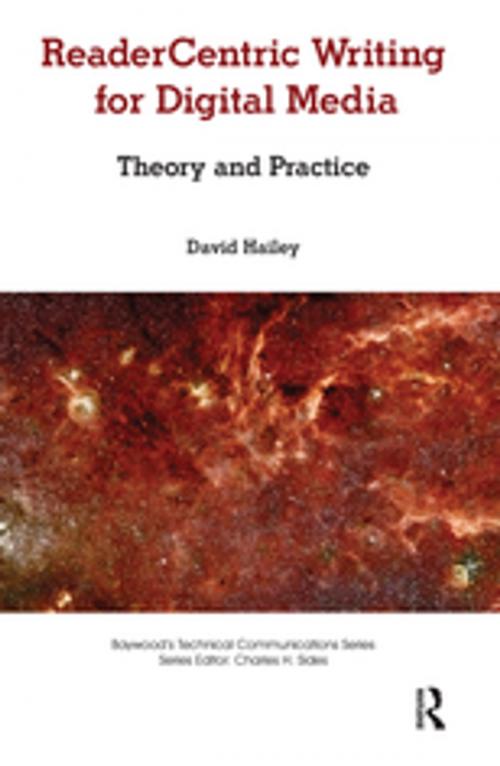Readercentric Writing for Digital Media
Theory and Practice
Nonfiction, Health & Well Being, Psychology, Mental Health| Author: | David Hailey | ISBN: | 9781351864718 |
| Publisher: | Taylor and Francis | Publication: | December 5, 2016 |
| Imprint: | Routledge | Language: | English |
| Author: | David Hailey |
| ISBN: | 9781351864718 |
| Publisher: | Taylor and Francis |
| Publication: | December 5, 2016 |
| Imprint: | Routledge |
| Language: | English |
This book presents an altogether new approach to writing and evaluating writing in digital media. It suggests that usability theory provides few tools for evaluating content, because usability theory assumes only one kind of writing on the Internet. The author suggests three models: user-centric (usability model), persuasion-centric (encouraging the reader to linger and be persuaded--Canon camera ads), and quality-centric (encouraging the reader to linger and learn or be entertained because of the quality of the writing--NASA.gov and YouTube).
Designed for professional writers and writing students, this text provides a rubric for writing in digital media, but more importantly, it provides a rubric and vocabulary for identifying and explaining problems in copy that already exists. The Internet has become a pastiche of cut-and-paste content, often placed by non-writers to fill space for no particular reason or by computers with no oversight from humans (e.g., Amazon.com). Because these snippets are typically on topic (but often for the wrong purpose or audience), professional writers have difficulty identifying the problems and an even harder time explaining them. Finding an effective tool for identifying and explaining problems in digital content becomes a particularly important problem as writers increasingly struggle with growing complications in complex information systems (systems that create and manage their own content with little human intervention). Being able to look at a body of copy and immediately see that it is problematic is an important skill that is lacking in a surprising number of professional writers.
This book presents an altogether new approach to writing and evaluating writing in digital media. It suggests that usability theory provides few tools for evaluating content, because usability theory assumes only one kind of writing on the Internet. The author suggests three models: user-centric (usability model), persuasion-centric (encouraging the reader to linger and be persuaded--Canon camera ads), and quality-centric (encouraging the reader to linger and learn or be entertained because of the quality of the writing--NASA.gov and YouTube).
Designed for professional writers and writing students, this text provides a rubric for writing in digital media, but more importantly, it provides a rubric and vocabulary for identifying and explaining problems in copy that already exists. The Internet has become a pastiche of cut-and-paste content, often placed by non-writers to fill space for no particular reason or by computers with no oversight from humans (e.g., Amazon.com). Because these snippets are typically on topic (but often for the wrong purpose or audience), professional writers have difficulty identifying the problems and an even harder time explaining them. Finding an effective tool for identifying and explaining problems in digital content becomes a particularly important problem as writers increasingly struggle with growing complications in complex information systems (systems that create and manage their own content with little human intervention). Being able to look at a body of copy and immediately see that it is problematic is an important skill that is lacking in a surprising number of professional writers.















